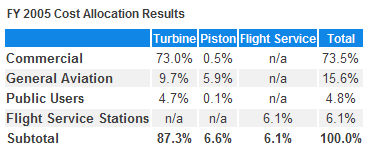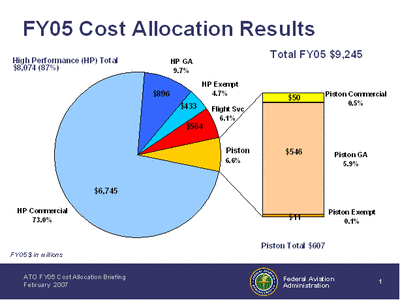Wed, Feb 14, 2007
Agency Worked With National Accounting Firm To Determine
Allocations
 How did the Federal Aviation
Administration arrive at its decision to increase fees operators of
smaller aircraft would pay under its proposed new funding scheme?
The FAA states it worked with accounting firm
PriceWaterhouseCoopers to designed what the agency calls "a simple,
transparent, thorough, and repeatable cost allocation
methodology."
How did the Federal Aviation
Administration arrive at its decision to increase fees operators of
smaller aircraft would pay under its proposed new funding scheme?
The FAA states it worked with accounting firm
PriceWaterhouseCoopers to designed what the agency calls "a simple,
transparent, thorough, and repeatable cost allocation
methodology."
The FAA used FY 2005 Cost Accounting System data -- which the
agency says is the most detailed and comprehensive cost data
available as the proposal was being developed -- to distinguish
between two types of users:
- Turbine-powered aircraft (jets and turboprops)
users drive most system costs because they fly in all weather, at
all times of the day, tend to be time-sensitive, generally compete
for the same air traffic control resources, and require complex air
traffic equipment and procedures.
- Piston aircraft and helicopter users, who
typically fly lower and slower than turbine pilots. These aircraft
typically fly less complex equipment, tend to be less time
sensitive, frequently fly under visual flight rules, and require
different types of air traffic control resources.
The FAA allocated the costs of more than 600 Cost Accounting
System projects between these two user types and determined that,
in most cases, piston users were responsible for only a share of
incremental costs. The total FY 2006 air traffic costs were
allocated as follows:

- 87% to turbine users,
- 7% to piston users, and
- 6% to flight service stations (expected to decline in future
years).
Within each group, the FAA divided costs among commercial,
general aviation and public users based on their share of activity.
In the terminal environment, the allocation looks at costs and
activity within groups of similarly-sized airports. As a result,
users of less costly facilities do not bear the costs of more
expensive facilities.
This table summarizes the FY 2005 cost allocation results,
according to the FAA:

Flight Service Station costs are not allocated among users,
because costs are expected to decline substantially in future years
(one assumes, due to increased privitization of the service --
Ed.) and the cost recovery proposal funds these costs from the
General Fund.
More News
Mid-Continent Instruments and Avionics and True Blue Power ANN's NBAA 2025 Coverage... Visit Them At Booth #3436 101 Aviation Nears STC Approval for Lithium Battery Upgrade on Gulf>[...]
Hertz The standard radio equivalent of frequency in cycles per second of an electromagnetic wave. Kilohertz (kHz) is a frequency of one thousand cycles per second. Megahertz (MHz) >[...]
“NATCA does not endorse, support, or condone any federal employees participating in or endorsing a coordinated activity that negatively affects the capacity of the NAS, or an>[...]
Aero Linx: European Association for Aviation Psychology (EAAP) Since 1956 the European Association for Aviation Psychology (EAAP) provides a forum for professionals working in the >[...]
Aircraft Experienced A Total Loss Of Engine Power During A Go-Around Attempt And Then Impacted A Soybean Field On September 13, 2025, at 1625 eastern daylight time, a Pegasus Quant>[...]
 True Blue Power and Mid-Continent Instruments and Avionics Power NBAA25 Coverage
True Blue Power and Mid-Continent Instruments and Avionics Power NBAA25 Coverage ANN's Daily Aero-Term (10.11.25): Hertz
ANN's Daily Aero-Term (10.11.25): Hertz Aero-News: Quote of the Day (10.11.25)
Aero-News: Quote of the Day (10.11.25) ANN's Daily Aero-Linx (10.11.25)
ANN's Daily Aero-Linx (10.11.25) NTSB Prelim: Pegasus Quantum 15
NTSB Prelim: Pegasus Quantum 15





